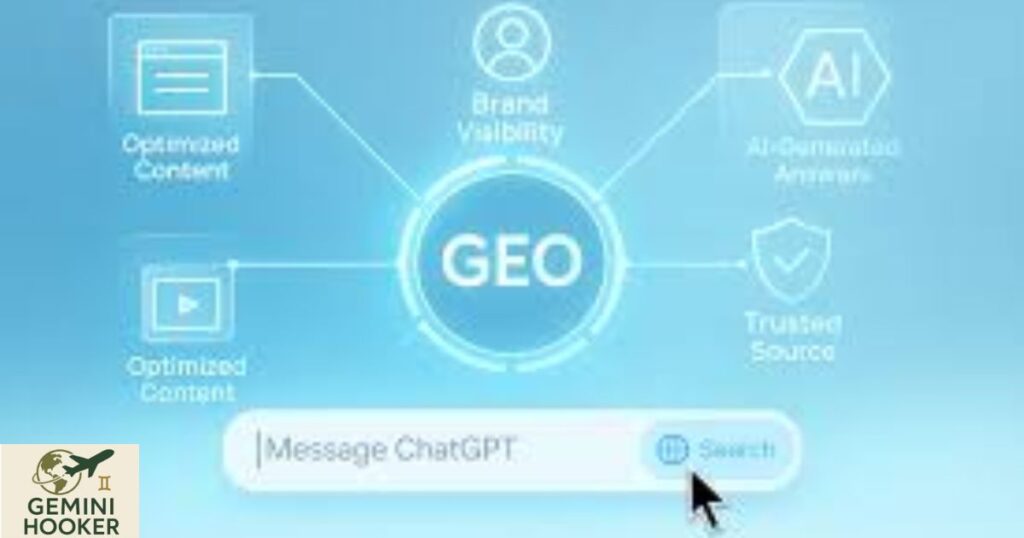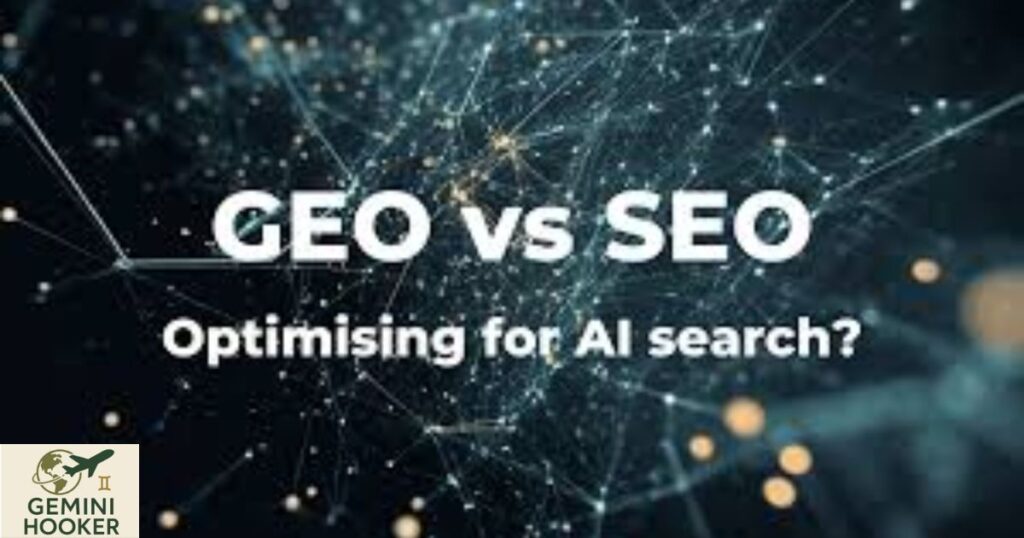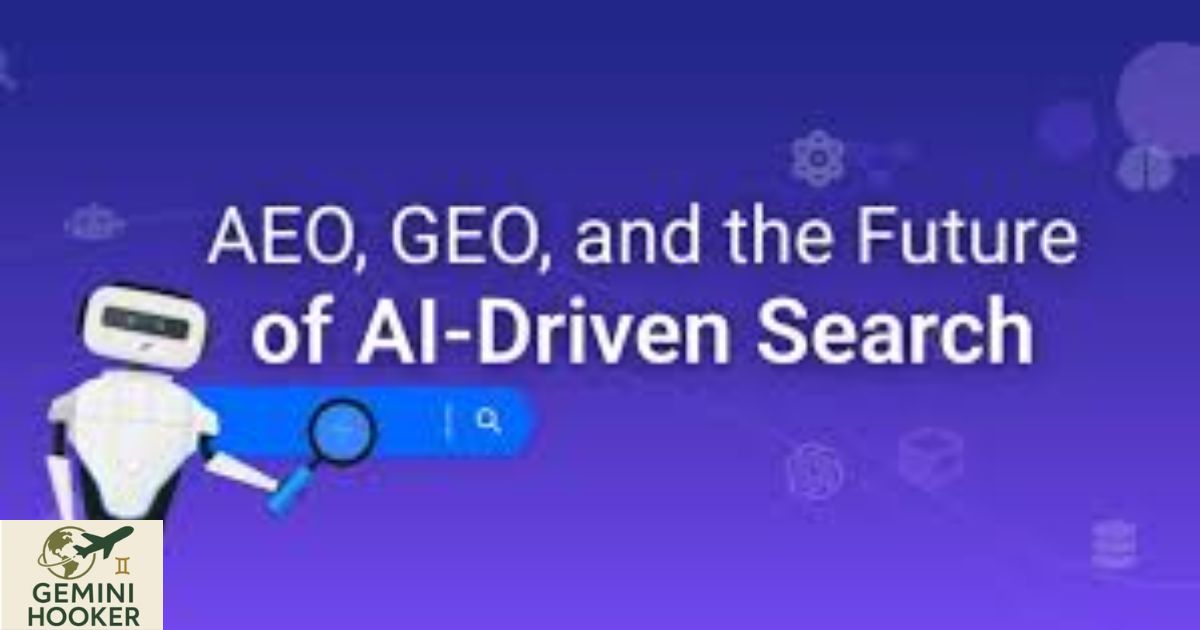GEO
The current digital environment, which is continuing to evolve rapidly, is a phase that is changing drastically, where people seek to access information. Online visibility has always been pegged on traditional Search Engine Optimization (SEO).
With the emergence of generative AI-based search engines, though, a different strategy is required: the Generative Engine Optimization (GEO).
GEO focuses on optimizing content not just for search engine rankings but for inclusion in AI-generated answers across platforms like Google AI Overviews, ChatGPT, Microsoft Bing Copilot, and others.
This article dives deep into what GEO is, why it matters, and how to implement it to future-proof your digital presence.
2. Understanding GEO (Generative Engine Optimisation)
Generative Engine Optimisation (GEO) is the art and science of making your content AI-readable, AI-quotable, and AI-citable. Unlike traditional SEO, which focuses on climbing search engine rankings, GEO ensures that generative AI platforms—such as Google’s AI Overviews, OpenAI’s ChatGPT, Microsoft Copilot, Perplexity AI, and Anthropic Claude—select your content when they generate an answer to a user’s query.
Where SEO competes for clicks, GEO competes for inclusion in the answer itself. In the age of AI-driven discovery, being part of the generated response can be more valuable than ranking in the top three organic results.
How GEO Works
When a user asks a question in a generative engine:
The AI model scans its training data and live web sources (if available).
It looks for reliable, structured, and contextually relevant content.
The system either quotes the content directly, summarises it, or uses it to form part of a synthesised answer.
High-authority, clearly structured, and semantically rich pages have a greater chance of being included.
Example:
A health website with structured data, clear FAQs, and authoritative medical citations is more likely to appear in AI-generated health advice than a generic blog post without citations.
A travel site with fact-checked itineraries and location-specific schema markup can get cited in Google AI Overviews when users search “7-day Japan travel plan”.
LSI & NLP Keywords Related to GEO
To optimize for GEO, you must use semantically connected terms (LSI) and natural language phrases (NLP). For example:
AI content visibility
Generative search optimisation
Conversational query matching
AI citation building
Semantic content structure
Machine-readable data
Fact-based AI sourcing
These terms help align your content with the way AI systems process and interpret information.

Why GEO Matters Now
There is an increased adoption of AI: generative search tools are being incorporated in our daily work processes, including research and purchases.
E-E-A-T Relevance: Content with any signals of Experience, Expertise, Authoritativeness, and Trustworthiness is preferred in AI systems.
Less Reliance on Ordinary SERPs: A big chunk of the AI users do not even get to see the search results page since they receive the answer.
In short, GEO is the bridge between your content and AI’s ability to present it as the answer. Without it, your brand risks being invisible in the next generation of search.
3. The Evolution from SEO to GEO
For over 20 years, Search Engine Optimisation (SEO) has been the backbone of digital visibility. The process was straightforward in theory:
Research keywords people are searching for..
Create high-quality content around those keywords.
Earn backlinks and improve technical site performance.
Climb the SERPs (Search Engine Results Pages) to capture clicks.
This approach worked because search engines were the gatekeepers of online information. But in 2023–2025, the rise of AI-powered search engines has started to rewrite the rules.
From Keywords to Conversations
The old-fashioned SEO was focused on keywords. You focused on such sad expressions as ”b’t coffee maker 202′ or ‘SEOSEO tip for begbeginnersAI-based search, however, is user-focused on intent in natural language. The users are asking rather than using keywords:
And my question is, which is the best coffee machine in any small kitchen on a budget of less than 200 dollars?
AI engines such as ChatGPT, Google AI Overviews, and Perplexity do well and frequently do not redirect the user to another webpage.
SERPs to Direct Answers
The SEO age rank of 1 translates to the utmost visibility. During the Geraera, the 1 spot is within the created response. This implies that persons who hold the best organic position may find themselves nowhere in what is read by the user in the absence of AI-optimized content.
Ascending through Signals – AII Signals
Even today, search engines will take into consideration such elements as backlinks, page speed, and meta descriptions. Generative AI tools are, nevertheless, centred on:
Unambiguous, responsive, fact-oriented information
The theory of E-E-A-T concerns the values of author credibility.
Up-to-date information
Semantic clarity and context relevance
SEO vs GEO – Key Differences
Factor SEO GEO
Goal:al: Higher position in SERPs, Inclusion in AI-generated answers
Focus Keywords, backlinks, metadata, Structured data, natural language, AI citations
User Query SStyle: Short, keyword-based, conversational,l, multi-intent
Primary Audience: Search engine crawlers, Generative AI models
Success Metric: Organic traffic, click-through rate (CTR), AI citations, brand mentions in AI responses
ContentFormat:t: Blog posts, landing pages,s, FAQs, structured answers, fact sheets
Why This Shift Matters
Gen Z and younger Millennials are going to turn to AI as a source of answers more and more.
GEO strategies allow those brands not to be lost under the awareness of the user, although they have excellent outputs as regards SEO positions.
GEO does not and should not replace SEO; it adds layers of AI-driven optimisations that do not rule out traditional best practices.
4. The Need for GEO 2025
So, in the same way that the devotion of RFs to the development of RFs (Sasin and Coskun 2008) is no longer simply an experiment but a mandatory precondition of digital marketing, Generative Engine OOptimisation(GEO), by the year 2025, will have effectively ceased being an at all experimental process but will have evolved across a spectrum to encompass the necessary precondition of digital marketing.
It is quite straightforward: user behaviour, technology, and competition have all changed so dramatically that AI-driven visibility is as important as ordinary search ranking.
It is no longer a secret that AI-powered search is becoming mainstream.
Assistant technologies such as Google AI Overviews, ChatGPT with browsing, Bing Copilot, and Perplexity AI have crossed the barrier into mainstream usage.
The surveys conducted in the field indicate that over 60 per cent of the internet users currently use the A-generated answers to make their decisions in a rush, such as product research or medical questions.
2. Falling Click-Throughs among the Old School Search
Since Google displays AI summaries over its SERPs, it is users who are receiving the answer without the need to click. In certain niches, organic CTR has decreased by 20 to 40 percent in competitive niches.
With GEO, you may well end up as invisible, no matter how high or how high your ranking may be.
3. E-E-A-T and Building Authority
Content based on experience, expertise, authoritativeness, and trustworthiness is more likely to be favored by AI systems. GEO strategies such as referencing reliable sources, organising factual information, and expressing content in a straightforward manner are strategies that will assist you in getting/getting selected as a reliable source.
4. Competitive Advantage
Many businesses still think SEO is enough. By implementing SEO now, you can:
Secure early placement in AI-generated answers..
Build long-term trust with AI models..
Outrank competitors in both traditional search and generative engines..
5. Future protection online: What can you protect yourself with?
Generative AI is not a trend; it is an architectural shift in how the mass population is accessing information. GEO will make you visible in the following five years of search development, no matter how search platforms might alter their layout or algorithm.
Succinctly, GEO is no longer an option; it has become the second brick of online presence. By treating it now as an option, we will only be playing catch-up tomorrow, where there will be competitors who are capturing brand mentions and traffic on their ChatGPT responses.

5. GEO premises
The Generative Engine Optimisation (GEO) is built with ideologies with which to ensure your content becomes more visible, understandable, and trustworthy by AI-based search engines. Although the tactics might change, such principles will help achieve success in 2025 and further ahead.
1. Conversational Relevance
As opposed to classical SEO, where it is commonplace to consider short-tail words, GEO works with natural language and conversational search queries.
Answers to multi-part questions are provided by AI instruments.
In the tone and language that users use to talk or type, your content has to tackle these.
Example:
GEO-optimised content would include, rather than just targeting the subject matter of best running shoes:
“Which are the most suitable running shoes when you have flat feet and run long distances?”
2. Intended, systematised data
Generative engines are efficient when the information is in a form that allows it to be organised and verified.
Be clear by using clarifications in the form of bullet points, numbered lists, and tables.
Present statistics, dates, facts, or other representations from high-quality sources.
References – support every main point with references– AI models like fact-checked statistics.
3. Intelligibility of semantic stuff
Semantic understanding is the basis of AI systems that involve the recognition of
4. E-E-A-T Compliance
At GEO, the success of the company lies in experience, expertise, authority, and trustworthiness.
Give the credentials of the author of the show.
Consider the official information.
Keep the content new– the AI systems perform better with the new data.
5. AI-Friendly Formatting
The aesthetics of formatting is only a part of the equation: formatting is also about machine readability.
Using the H1, H2, and H3 texts and headings that form the separative boundary lines to the sections.
Make paragraphs short (2-4sentences).
Make sure that the content is easily parsable by having a schema mark and an implementation of an FAQ section.
6. Continuous Adaptation
Generative AI is still evolving, which means GEO strategies must adapt.
Monitor your AI citations and inclusion frequency.
Update content regularly based on new AI behaviours..
6. Step-by-Step GEO Implementation Strategy
When implemented properly, Generative Engine Optimisation (GEO) should be tackled in a controlled way.
So, how do you ensure that your written piece looks to and is addressed by AI engine search engines of the future, twenty-five years onwards in 2025? This is a precise step-by-step procedure to bring it into reality.
First, trends in AI queries are identified.
Determine the wording of the conversation with the help of AI-oriented keyword analysis tools like AnswerThePublic, ChatGPT, or machine AI overviews listed on Google.
Search keywords of the long-tail question type where the user intent is apparent.
On Google, you are able to research people and also ask (PAA) columns to find out common questions about AI.
Tips:
Keep track of hot topics and questions in the dynamic.
You ought to target queries that are not relevant to your opponents.
Step 2: Competitor AI Quotes
Look to see what the AI tools used, like ChatGPT or Google overviews, refer to in the context of the content of competitors.
Use SEMrush, Ahrefs, or Surfer SEO to check the traffic and backlinks of what can be potentially crawled by the AI, what the backlinks are, and how the content is structured.
An example was set for them through their formatting, text, and well-informed content.
Step 3: AI-Readable Organising Content
Very rigidly structure the headings (H1, H2,2, H3).
Bring bullet points and the usage of numbered lists and tables, and the successful employment of tables.
Add FAQs to answer the commonly asked questions of the users straight away.
Example:
Instead of one long paragraph about what the product is about, list as follows:
Long-lasting battery (up to 24 hours)
Protected against water (IP68)
The payment lifeline/losing weight
Step 4: Insert LSI and NLP wordings..
Use Latent Semantic Indexing (LSI) keywords that refer to the topic of your main subject to provide semantic definition.
Do not use the fixed keywords, but rather use phrases that are used in natural language and terms of conversation.
Do not stuff keywords; stress comprehensiveness of the topic.pic.
Step 5: Structured data (Schema Markup)
The schema.org markup will assist AI engines to know the kind of content on your site (articles, FAQ, products, etc.).
Take advantage of the use of both the HowTo schema and the FAQ schema.
After structuring the data, you will have a better chance that the content will appear in rich results and AI summaries.
Step 6: Log Log High-E-E-A-T All the time
Present life and qualifications for writing.
One should also ensure that he/she is up-to-date.
Best Tip 7: A voice-search-compatible site
Ask people to review and give testimonials where appropriate.
No. 7 voice search: everything is at its best.
Most questions on AI are made through voice assistants, so jot down information in a clear and succinct manner.
Use whatever words you use.
Include local and intent-based filters (e.g., near me, best affordable, etc.).
AI Performance And Adjust Step 8
Seek citations such as AI and mention it through such tools as Google Search Console and brand monitoring tools.
After changing your AI behavior into something that you are happy about based on the feedback, edit and refine your content.
Avoid keeping outdated information and updates, but change your information and make it seem fresh every now and then.
Summary Checklist
Discover for yourself things people want to talk about..
Citing the article used by AI, the research rival
Yours should be of a logically coherent format with headings..
LSI and natural language keywords ought to be combined..
Enable schema markup, structured data.
Create Bad Eater, E-A-T messaging
Write. abAboutoice search..
Rephrase & rewrite continuously.
7. The advantages of having GEO and SEO partnerships: Benefits of Combining GEO with SEO
Though SEO has been the pillar of digital marketing over the last several decades, combining it with Generative Engine Optimisation (GEO) has formed a synergy that will future-proof your online presence.
This is how the new awareness and importance of both strategies together in modern 2025 and further:
1. Greater cross-platform exposure.
Optimising to attract traditional search engines as well as generative AI means that your content will be seen by more users on more platforms, everything from Google SERPs to AI bots on ChatGPT, Bing Copilot, and Google AI Overviews.
2. Growth in the authority and trust of a brand.
The authority and credibility of your brand enlarge your AI tools to cite you through the use of your material.
This not only improves your image in the eyes of AI systems but also helps users who better find your content more easily.
3. The multiplicity of sources of traffic.
SEO attracts organic search traffic, whereas GEO will assist in capturing AI-driven referral traffic– those users who find answers on AI-powered solutions and come to your site to find out more. This reduces dependence on a source of traffic.
4. To enhance content interaction and user experience.
GEO promotes producing organised, readable, and conversational content that will match how users pose queries readily.
This increases the engagement rate, reduces the bounce rate, and increases conversions.
5. A changing search landscape, competitive edge
The fact is that many competitors only engage in the SEO method. The integration of GEO provides a first-mover advantage in the new AI-enabled search landscape to ensure you maintain a competitive position in your industry.
6. Better Quality and Relevance of Content Enhancement
The importance of E-E-A-T concepts, semantically relevant information, and fresh content has given GEO an edge in the overall quality of content, and those are also good for SEO results.
7. Innovation, Future Search, Adaptability
With the help of SEO and SEO, the content will be more ready to respond to future algorithms and AI changes, so it will maximise its visibility and success in the long term.
Keywords LSI/NLP:
High-performance search via AI
Multi-site text unveil
Ranking in search engines through conversation
Brand trust AI citation
Semantic SEO and artificial intelligence. The semantic SEO performs the engagement by connecting the semantic web to the AI.
8. Conclusion
Generative Engine Optimisation (GEO) is a feature that was assigned to be a luxury before, but now the world of digital content develops so fast that previously separating factors have become essential. Despite the inability to overlook conventional SEO, the implementation of artificial intelligence-powered search tools has altered the search and utilisation of online information.
When you learn and apply GEO, you will make sure your information is not only received but also sted, cited and included as an answer to an AI question – unlocking new sources of traffic and brand dominance.
The secret is to accept the use of conversation relevance, structured data, E-E-A-T concepts, and constant changes to the rapidly growing AI environment. Attaching GEO to the SEO you (already) employ places you on the headwaters of search innovation and can future-proof your digital presence and enhance it against the vicissitudes of algorithmic changes.
F&Q
Q1: What is GEO, or what makes it different from SEO?
A: GEO (Generative Engine Optimisation) is the content optimisation to place AI-generated answers, and it concerns conversational language, structured data, and AI citations. SEO is concerned with the placement on conventional search engine results pages (SERPs) on the basis of keywords and backlinks.
Q2: Why will GEO matter in 2025?
A: As people implement more AI, they are being given direct responses to questions via AI programmes without having to click on a link in the conventional way. GEO makes sure that you get noticed in these AI responses and retain visibility and authority.
Q3: How will I find suitable queries for SEO optimisation?
A: AI keyword research: Tools such as AnswerThePublic, AI Overviews in Google, or by analysing People Also Ask will help identify conversational and question-based keywords in your niche.
Q4: What are the main principles of GEO?
A: Relevance of conversation, format of factual knowledge, semantic context, a good E-E-A-T, AI-friendly formatting, and constant adaptation according to AI trends.
Q5: Is it possible that GEO can substitute old-school SEO?
A: No, and GEO supplements SEO. The integration of the two tactics ensures the greatest visibility on both search engines and AI-based engines.
Q6: What is the way to monitor the effectiveness of GEO?
A: To check AI mentions, brand exposure, and visibility, one could use software instruments such as Google Search Console, AI monitoring services, and brand monitoring tools. Replace the content every now and then based on AI behavioural changes.

